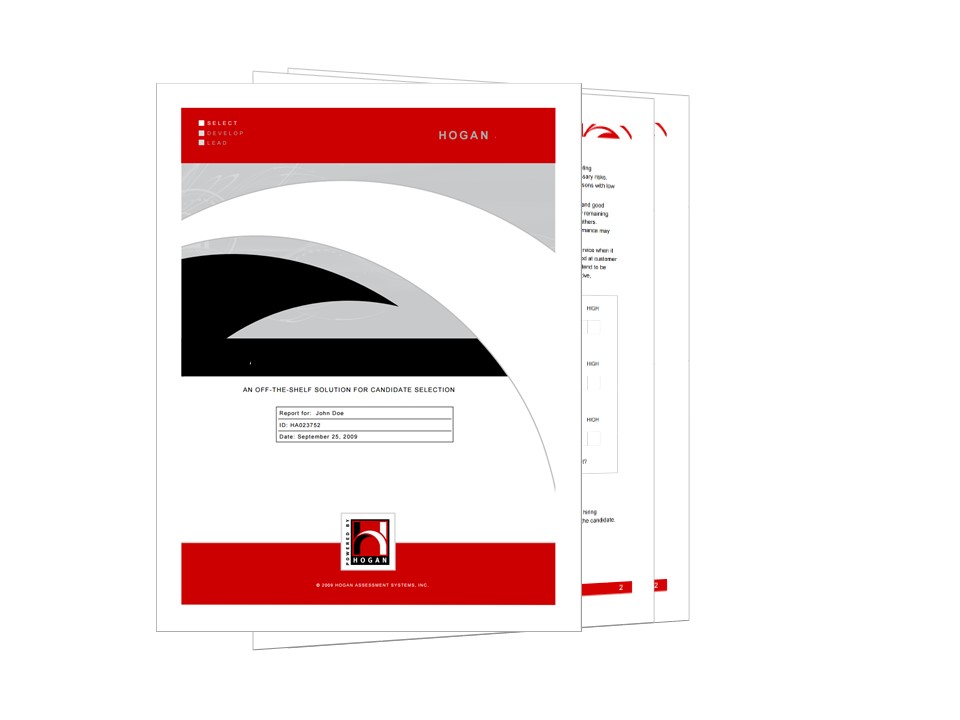Hogan Development Survey (HDS)
The Hogan Development Survey (HDS) assesses 11 common dysfunctional dispositions that interfere with a person's ability to build relationships with others and create cohesive, goal oriented teams. The counterproductive behaviours associated with these dysfunctional dispositions negatively influence people's careers, relationship, and life satisfactions.
Although the traits of the HPI can easily be seen in a person's day-to-day behaviours, the dysfunctional dispositions of the HDS will only be seen in situations where the person is not actively managing their public image. These situations might include those with high stress or change, multi-tasking, task saturation or accomplishment, poor person-job fit, or when a person feels comfortable enough with those they work with that they no longer manage their public image.

KEY BENEFITS
- Studies using HPI and HDS indicated that traits assessed by the HDS were valid predictors of job performance.
- Several versions of the HDS have been developed. The current version was published in 1997 and consists of 11 primary scales and 168 items.
- Over 500 000 people have taken the HDS. Most of these individuals worked in sensitive individual contributor or leadership roles.
- There are no practical gender or ethnic differences in scale scores.
- There are three major types of reports, which include Suitability, Career, and Leadership Forecast Series reports.
- The HDS provides percentile scores for the 11 primary scales. These scores are based on general population, manager, or executive norms.
ASSESSMENT SCALES

The HDS contains 11 Primary Scales.
- Excitable – Composure and ability under pressure, team work and interpersonal skills
- Sceptical – Argumentative, critical thinking, interpersonal skills
- Cautious – Decision making ability, ability to adapt, ability to take control
- Reserved – Interpersonal, team work, and communication skills
- Leisurely – Degree of assertiveness, ability to adapt, work ethic
- Bold – Self confidence, arrogance, ability to take responsibility for actions
- Mischievous – Intuitive, willingness to work within guidelines, risk taking, impulsive
- Colourful – Attention seeking, listening skills, productivity, ability in crises, belief in self and ability
- Imaginative – Influencing and persuasive ability, ability to think laterally, foresight
- Diligent – Attention to detail, ability to delegate, ability under pressure, decisiveness
- Dutiful – Compliant, ability to conform, decision making ability, argumentative ability

TECHNICAL FACTS

The HDS contains 168 items that are keyed true and false. The items have been carefully reviewed for invasive or intrusive content and to ensure the inventory has no adverse impact on race/ethnicity or gender. The total completion time is 15 - 20 minutes with a 5th grade reading level.
The HDS is often referred to as an inventory of the "dark side" of personality. It was developed to measure the domain of interpersonal behaviours existing between normal personality as measured by the Hogan Personality Inventory. The HDS scales focus on the ends of the distribution of normal personality characteristics. For example, people with high scores on the Five-Factor dimension of Conscientiousness may be at risk for the HDS derailer Diligent. Conversely, those with low scores may be at risk for the HDS derailer Mischievous.
The original norms for the inventory were based on the responses of 10 000 employed adults form a variety of industries including health care, banking and finance, food service, construction and transportation. More than 300 000 people have completed the HDS over the past 10 years and it continues to be the only inventory designed to measure leadership derailers.
HDS scores are stable over time with test-retest reliabilities ranging form .58 to .87. However, a focuses development effort can reduce the risk associated with high scaled-scores. The HDS has been validated in over 50 organisations across a wired range of occupational categories. Most of the validation research has involved liking HDS scale-scores with ratings of managerial competencies.
REPORTS FOR SELECTION PROJECTS
The following reports are designed for selection projects
Graphic
The Graphic Report is primarily used for selection decisions. The report includes a description of the seven primary scales and six occupational scales as well as numerical scores and graphic presentations.
Interpretive Report
The Interpretive Report is primarily used for selection decisions. The report includes a description for each of the 15 scales as well as numerical scores and graphic presentations. In addition the report includes an interpretation of the behavioural implications for each scale.
Basis Report
The Basis Report is primarily used for selection decisions. The report includes a description of each of the 15 scales as well as graphical and numerical scores. The report also includes a comparison with important job fit criteria as well as a comprehensive description of the candidate’s strength and areas of concern.
REPORTS FOR DEVELOPMENT PROJECTS
The following reports are designed for selection projects
Hogan Lead
The series includes four reports which can be either provided as a battery or individually.
Potential Report
The potential report is primarily used for development decisions. The report includes a description of the 15 scales as well as a graphical and numerical scores. The report also includes a comparison with the executives with similar profiles as well as detailed development recommendations.
Challenge Report
The challenge report is primarily used for development decisions. The report includes a description of the 11 scales as well as a graphical and numerical scores. The report also includes a comparison with the executives with similar profiles as well as detailed development recommendations.
Values Report
The Values report uses the MVPI test to compare scores of executives with other similar profiles. The report provides graphical and numerical scores.
Coaching Report
The Coaching Report is primarily used for development decisions. The report integrates the information from the Potential (HPI) Challenge (HDS) and Values (MVPI) reports. It builds a self-guided, comprehensive development planning tool as well as detailed recommendations.
Hogan Develop
The Performance Management Series Report includes three separate reports and can be provided either as a battery or individually.
Career Builder Report
The Career Builder Report is primarily used for development decisions. The report includes a description of the 15 scales as well as graphical and numerical scores. The report identifies the strengths and shortcomings of the individual taking the assessment and also includes detailed developmental tips.
Management Builder
The Management Builder Report includes a description of the 15 scales as well as graphical and numerical scores. The report highlights what the most effective techniques would be for managing the applicant if they were to join company team.
Career Compass
The Career Compass Report includes an outline of the occupational significance of a person’s core values and therefore provides effective career planning information.


